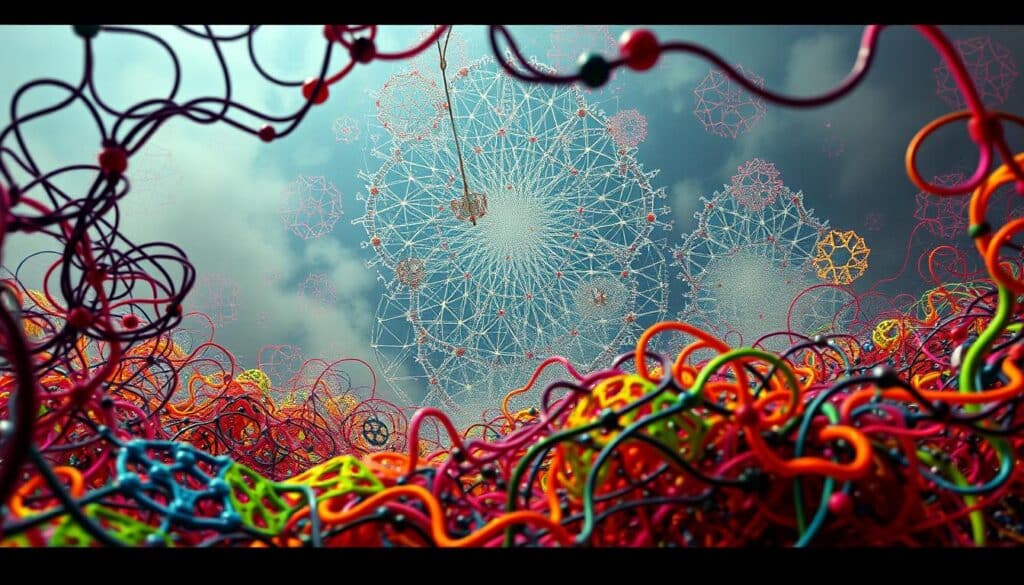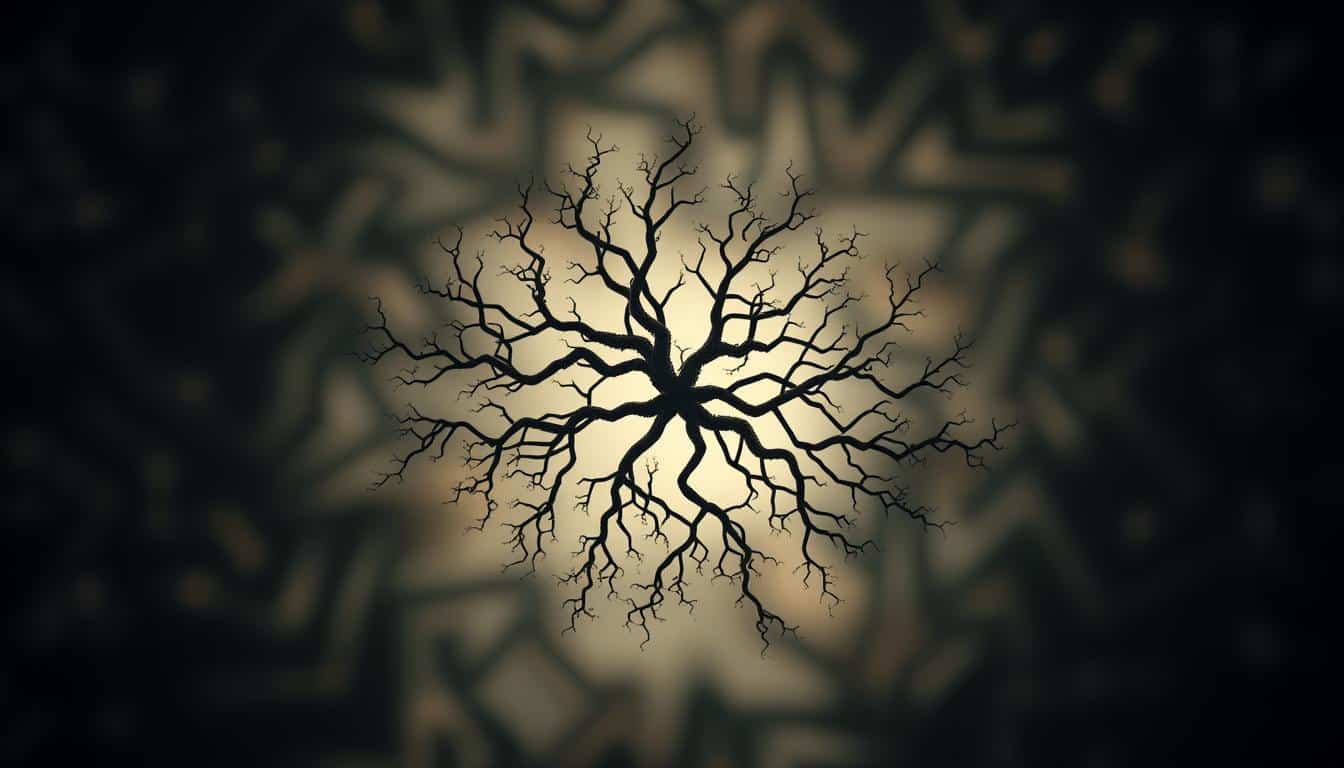Fractals and chaos theory are key in grasping nature’s complexity. They show us how everything is connected through patterns and unpredictability. Chaos theory focuses on how tiny changes can greatly alter results.
Fractals introduce us to the amazing concept of self-similarity in nature. This means, no matter how close you look, you’ll find endless complexity. Through this journey, we’ll dive into the scientific ideas behind fractals and chaos theory. These ideas greatly improve our understanding of natural and societal phenomena.
Introduction to Chaos Theory
Chaos theory explores the unpredictable in nonlinear dynamics, focusing on how tiny changes can lead to big outcomes. This is often shown through the “butterfly effect.” Here, small causes can have large effects. Unlike other sciences aiming for predictability, chaos theory reveals the complexities in real-world situations.
Understanding the Basics of Nonlinear Dynamics
Nonlinear dynamics looks at how elements within a system can interact in surprising ways. Unlike linear systems with predictable outcomes, nonlinear dynamics often results in chaos. This unpredictability opens new paths in many fields, including weather, biology, and economics. Scientists find these insights valuable, as they upend old ideas of order and delve into the nature of chaos.
The Significance of Chaos in Science
Chaos theory is key to deeper scientific insights. It shows us that systems, like the weather or ecosystems, follow complex paths instead of being purely random. This changes how we think about forecasting. The impact of chaos stretches across various fields, including how we model climate or understand financial markets. This theory provides tools for handling the complexity we encounter in nature and society.

What are Fractals?
Fractals are amazing, endlessly detailed structures. They show off self-similarity, mirroring nature’s patterns on all scales. This feature lets us see complex details up close or from afar. By understanding fractals, we gain a deep appreciation for nature’s patterns.
The Concept of Self-Similarity in Fractals
The core of fractals is self-symmetry. This means small parts of a fractal look like the whole thing. We see this in nature, like how trees branch out or how leaves are structured. Each part of the fractal stays consistent, no matter the size. This makes fractals fascinating in both art and science.
Examples of Fractals in Nature
Nature shows us how beautiful and complex fractals are. They include:
- Coastlines, with their intricate shapes, repeat patterns at any zoom level.
- Trees and branches that keep a similar pattern as they grow.
- Clouds that form fractal-like wisps and shapes across the sky.
- Snowflakes with unique yet symmetrical designs, showing self-similarity in ice.
These examples show how fractals model complex structures in nature. They connect math with the natural world around us.
The Connection Between Fractals and Chaos Theory
Fractals and chaos theory show how order and disorder intertwine in complex systems. Chaos brings randomness and unpredictability. Yet, fractals show structured patterns within that chaos. This shows that what seems disorderly can be organized on another level.
Understanding the Relationship between Order and Disorder
It’s key to see how order can exist with disorder through fractals. Fractals have self-similar structures that suggest order amidst complexity. They reveal patterns in chaotic behaviors in nature. By understanding this, we see how systems work, showing organization in randomness.
Fractals and Chaos Theory: Understanding Complexity in Natural Systems
Fractal patterns help us understand the complexity in nature. These patterns appear in natural phenomena. They show us how chaos influences repetitive processes in nature.
How Fractal Patterns Emerge in Natural Phenomena
Nature creates patterns as chaos mixes with order. Coastlines and mountains have fractal traits because of earth’s forces. This lets us see nature’s events through a detailed view.
The Impact of Understanding These Systems on Predictability
Spotting fractal patterns helps predict the weather better. It lets meteorologists forecast with more accuracy. Knowing about the chaos helps us respond better to weather challenges.
The Butterfly Effect: A Principle of Chaos
The butterfly effect shows how small things can lead to big changes. It’s like when a butterfly flaps its wings, it might cause a storm far away. This idea tells us that even the smallest actions can have big results.
How Small Changes Can Lead to Major Outcomes
This concept changes how we predict things in science. It helps experts understand that small changes can affect weather, nature, and people’s actions. They use this knowledge to make better predictions in complex systems.
Chaos in Weather Systems
Chaos theory plays a big role in understanding weather. It shows how tiny differences can lead to big changes in weather. This helps experts get better at predicting what the weather will do.
The Role of Chaos Theory in Meteorology
Meteorologists use chaos theory to get why weather can be hard to predict. Even small changes can hugely affect forecasts. This makes weather models better but predicting remains tough.
Forecasting weather is still hard, even with new tech. Short forecasts are getting better, but long-term ones struggle. This is because it’s hard to know every small detail and how everything in the atmosphere interacts.
Fractals in the Human body
The human body is a marvel of design, showing amazing patterns known as fractals. These patterns are everywhere in our biology, making our bodies work better. They help us understand health and our bodies in new ways.
The Fractal Nature of Biological Structures
Fractals can be seen in parts of the human body such as:
- Blood vessels, branching out like trees to carry blood efficiently.
- Lungs, with bronchi and alveoli that reflect fractals for better breathing.
- Neural networks, with neurons linking in intricate fractal designs for quicker thinking.
This special design is not just beautiful. It shows how our bodies work so well.
Fractals in Medical Imaging and Research
Fractals are also key in medical imaging. They help us get better at diagnosing diseases. With fractals, images from medical tests can be clearer and more precise. This involves:
- Magnetic Resonance Imaging (MRI)
- Computed Tomography (CT) scans
- Ultrasound imaging
Using fractal analysis, doctors can check our bodies more thoroughly. Learning about fractals helps us understand more about how we’re built and how we function.
Understanding Order and Disorder
The ideas of order and disorder are key to understanding complex systems. Chaos goes beyond simple randomness. It shows patterns that develop between stable and unstable states. In many changing systems, chaos is seen as a state that shows a fine line between order and disorder.
Defining Chaos as a Transition State
Chaos is not just a breakdown of order. It is a phase where systems shift from predictable to unpredictable behaviors. This change helps experts find the rules that control different events in both natural and man-made settings.
Chaos acts as a link between order and disorder in several ways:
- It shows that chaos has structured behaviors that come from disorder, not just randomness.
- It proves that chaotic systems can become orderly again, showing the fluid nature of complex interactions.
- It explains the role of chaos in the growth of systems, which is important for areas like weather forecasting, biology, and economics.
Understanding these transition states is crucial for those looking to connect disorder with recognizable patterns. Learning about chaos in relation to order helps us grasp the complexity in different systems.
Turbulence and Mixing in Chaos Theory
Turbulence is key in the chaos theory, showing the complex actions in nonlinear fluid dynamics. Fluid particles move in unpredictable ways in turbulent systems. They often shift far from where they started over time. This happens because of the nonlinear interactions among the particles. Such interactions create a dynamic and hard-to-predict environment.
Mixing processes go hand in hand with turbulence. They are crucial in nature, affecting ocean currents and the air we breathe. Understanding their relationship helps us learn about the chaos in systems. This knowledge is valuable. It helps us explore both natural and created systems better, leading to new discoveries in many areas.
The Importance of Feedback in Chaotic Systems
Feedback is crucial in how chaotic systems, like financial markets, work. Studying the stock market shows us how investors create cycles of activity. These cycles make the market’s behavior more complex. As prices change, investor reactions can make these changes bigger or smaller.
In places like the stock market, feedback is key. Investor decisions often start trends. For example, if prices go up, people buy more. But if prices drop, people might sell in a panic. This back-and-forth makes the market’s prices move in unexpected ways.
Case Study: Stock Market Behavior Analysis
Looking at case studies, we see how feedback and market trends connect. Understanding these buying and selling patterns helps us get why markets are so volatile. Here are some key findings:
- Investor responses can greatly increase because of price changes.
- The market’s mood influences how much and in what direction people trade.
- Choices made by individuals can have big effects on overall market trends.
Grasping feedback in these systems helps analysts make models that take into account market swings. This is crucial for creating smart investment strategies.
Conclusion
The connection between fractals and chaos theory reveals deep insights into the complexity of natural systems. These ideas show us the patterns and unexpectedness in different phenomena. They are valuable for studying many scientific areas.
Understanding nonlinear dynamics and self-similarity helps us see the beauty in nature’s balance of order and chaos. This knowledge not only advances science but also helps us see the wonder in our surroundings. It leads to more discussions about the reality of our world and how we understand it.
Looking into fractals and chaos theory changes how we think about the world. It prepares us to better handle and appreciate the unpredictable yet orderly universe we live in.



